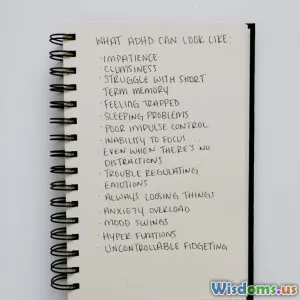
How Journaling Can Rewire Anxious Thought Patterns in Just 21 Days
7 min read Discover how journaling transforms anxious thoughts in just 21 days, rewiring the brain for calm and clarity. (0 Reviews)
How Journaling Can Rewire Anxious Thought Patterns in Just 21 Days
Anxiety often feels like an unrelenting storm in the mind—a cascade of negative thoughts tilting our perspective and stealing peace. What if you could literally rewire those anxious thought pathways, transforming your mental landscape one day at a time? Psychology and neuroscience reveal that through intentional journaling, this transformation is not only possible but achievable in just 21 days.
Journaling is a simple, accessible tool. Yet beneath its unassuming surface lies the power to foster neuroplasticity—the brain's ability to reorganize and form new neural connections, effectively altering how we process anxiety.
Understanding Anxiety and Brain Plasticity
Before delving into journaling techniques, it's crucial to understand the nature of anxiety and the brain’s adaptability.
Anxiety often manifests as patterns of automatic negative thoughts, heightened vigilance to threats, and amplified stress response. Neurologically, this involves hyperactivity in the amygdala (the brain’s alarm system) and decreased regulation from the prefrontal cortex (responsible for rational thinking).
Importantly, the brain is not static. Thanks to neuroplasticity, neural circuits can be reshaped. According to research from Dr. Norman Doidge, author of The Brain That Changes Itself, targeted mental exercises can weaken anxious circuits and strengthen mindful, calm pathways.
Why Journaling? The Science Behind Writing and Anxiety Reduction
Journaling taps into multiple therapeutic mechanisms simultaneously:
- Emotional Processing: Writing about fears allows emotional release and reduces mental clutter.
- Cognitive Restructuring: Reflecting on anxious thoughts helps identify and challenge distortions.
- Behavioral Activation: Tracking triggers and responses encourages proactive coping.
A landmark study published in the Journal of Experimental Psychology found that expressive writing improved working memory and reduced intrusive thoughts in anxious individuals, confirming journaling's practical impact.
The 21-Day Effect: How Habit Formation Encourages Rewiring
Why 21 days? This timeframe, popularized by psychologist Maxwell Maltz, is often cited as the period needed to instill new habits—a process confirmed by later studies (though habit formation can vary). Regular journaling daily for three weeks promotes consistency, reinforcing brain changes through repetition.
According to Dr. Phillippa Lally's research from University College London, it takes on average 66 days for new behaviors to become automatic. Yet, the first 21 days are critical for noticeable cognitive shifts, especially in reducing anxiety by retraining thought patterns.
Step-by-Step Guide: How to Journal for Anxiety Rewiring
1. Set a Daily Intention
Begin each session by setting a clear goal; for example, "Today I want to explore the thoughts making me anxious about work."
2. Free Write Your Anxieties
Spend 10-15 minutes writing without censorship. Express whatever arises, focusing on feelings, images, or worries. This helps externalize internal turmoil.
Example: "I keep worrying that I’ll mess up my presentation. What if I freeze and everyone notices?"
3. Identify Patterns and Triggers
Review your writing later to spot repetitive themes or situations triggering anxiety.
4. Challenge Negative Thoughts
Write counter-statements or evidence against anxious predictions.
Example: "I have prepared thoroughly before. Mistakes are human and won’t define my worth."
5. Practice Gratitude and Positive Visualization
End with acknowledging small wins or imagining positive outcomes, helping rewire toward optimism.
Real-World Insights: Success Stories
Consider Sarah, a graphic designer, who struggled with social anxiety. By journaling daily focusing on her anxious moments and reframing them, she reported significant shifts by day 15, gradually feeling more confident in social interactions.
In clinical practice, therapists often recommend journaling as a complementary technique for clients with anxiety disorders, backed by data showing reduced symptom severity over time.
Supporting Research and Expert Opinions
- Dr. James Pennebaker, a pioneer in expressive writing studies, demonstrated that individuals who journal about trauma and stress had improved immune function and decreased anxiety.
- A 2018 survey in Frontiers in Psychiatry reported a 45% improvement in anxiety symptoms among participants who practiced therapeutic journaling regularly.
Tips to Maximize Journaling Impact
- Consistency is key. Commit to at least 10 minutes daily.
- Create a comfortable, distraction-free space. Make it a ritual.
- Use prompts if stuck; e.g., "What am I feeling right now? Why?"
- Be honest and non-judgmental. Your journal is a safe space.
Conclusion: Embrace Journaling to Transform Anxiety
Anxiety need not be a permanent state of mind. By dedicating just 21 days to mindful journaling, you engage brain plasticity, rewiring anxious thought patterns into healthier, calmer pathways. This modest daily investment not only brings immediate relief through emotional expression but lays the foundation for lasting mental resilience.
So, whether you’re battling occasional worries or chronic anxiety, pick up a pen and start writing. Your brain—and your peace of mind—will thank you.
References
- Doidge, N. (2007). The Brain That Changes Itself. Viking.
- Pennebaker, J. W. (1997). Writing about emotional experiences as a therapeutic process. Psychological Science, 8(3), 162-166.
- Lally, P., van Jaarsveld, C. H. M., Potts, H. W. W., & Wardle, J. (2010). How habits are formed: Modelling habit formation in the real world. European Journal of Social Psychology, 40(6), 998-1009.
- Expressive writing and anxiety: A meta-analysis of research findings. Frontiers in Psychiatry, 2018.
Rate the Post
User Reviews
Popular Posts





















